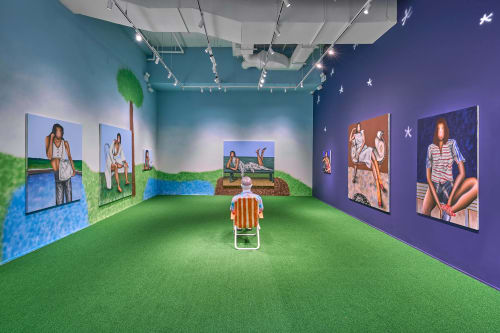Paradise Lost and Found by Evgen Čopi Gorišek : Central

WOAW Gallery is pleased to present Paradise Lost and Found, the Berlin-based artist Evgen Čopi Gorišek’s first solo exhibition in Hong Kong, at it’s Central location. Paradise Lost and Found will be on view from 17 January to 16 February, 2023. Paradise Lost and Found is also WOAW’s third exhibition with Gorišek, with two previous group exhibitions Romancing Relevance and Familia.
When in the late 15th century Hieronymus Bosch started conceptualizing his magnum opus The Garden of Earthly Delights, he was determined to portray the Catholic church’s idea of sin and its consequences. Driven by strong religious beliefs, he felt the urge to warn about the effect of worldly fleshy indulgence on the eternal afterlife. But what the Early Netherlandish master might’ve seen as a “fall from grace”, the 21st-century everyman sees as part of the human condition. And so, some 500 years later, Evgen Čopi Gorišek(b. 1994, Slovenia), took the essential elements of the epochal triptych to portray his vision of contemporary life and his own place in it.
Although religious propaganda inspired by medieval infernal literature and visualizations of misinterpreted biblical texts, this intensely moralistic work prompted the likes of Salvador Dalí to claim that Bosch should be labeled the first modern artist. Creating an early form of cinema with his highly entertaining conversation piece, inspired the Berlin-based artist to review the concept from a 21st-century viewpoint. Transforming the WOAW gallery’s venue in Hong Kong Central into an immersive installation, Čopi Gorišek’s Paradise Lost and Found is introducing an all-new body of work comprising works on canvas, a series of watercolor and pencil drawings on paper, and a life-size sculpture. Seated on the camping chair in the middle of the grassy ground, the chill picnic-goer is the centerpiece of this presentation. Radiating happiness and content while daydreaming about life through a repurposed mix of realism, metaphor, and fantasy, he is inviting the viewer to tag along on his journey to delightful revelation. Honoring the composition of the iconic triptych, the exhibition curated by Saša Bogojev divides the gallery walls into three sections but stays clear from going into the spiritual or religious sphere. Although sharing many of the elements of the original, such as the use of a common horizon, foreground with the main protagonists and story, midground with lush surroundings, flowers, and body of water, and background with manmade elements in the “hell” part, the updated vision is taking place in a public park instead of the mythical Garden of Eden.
Rather than confounding and confusing like Bosch’s visual world of metaphors did, the park and its attendees feel familiar, inviting, straightforward, and friendly. Referencing the archetypal romantic setting filled with greenery, flowers, and fountains, the story replaces the sinful pleasure with socializing, flirting, and easygoing lifestyle. Meaningful allegories understandable to the righteous elite are substituted with stylized portraits of seductive sitters whose appearance is their most important quality. Instead of audaciously portraying mostly nude characters, often subordinated, increasingly insecure or terrified, and in midst of shameless action, these fashionable muses are confidently posing for the artist and the viewer. Doubtless and fully aware of their own presence, they’re signifying a modern-day perception of the world and the accompanying absence of spiritual “paradise”. This shift becomes more obvious in the part of the exhibition meant to represent “hell”. Honoring the original idea to depict this section as a manmade world Čopi Gorišek’s vision of the netherworld is similar to the rest, just slightly dimmed as it takes place indoors. So where the 15th-century subjects feel suddenly ashamed of their bodies and actions or are getting punished, the up-to-date muses still act equally nonchalant and careless. Yet, their motionless grinning face brings back the Boschian sense of the grotesque, questioning their real emotive state against the polished shine of their clothes, accessories, and the perfection of their smooth skin. Perched up in the de-lighted nightlife setting evoking a club, house party, or back of an Uber, they’re steadfastly delighted to live in what the Renaissance master would likely describe as paradise lost.
— Saša Bogojev
Related artist
- X
- Tumblr

